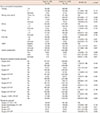Abstract
Purpose
Methods
Results
Figures and Tables
 | Figure 1Flow-chart of patients included in the analysis, starting from 6,325 women with primary breast cancer recorded by Modena Cancer Registry between 1996 and 2007. |
Table 1
Number of secondary malignancies observed between 1996 and 2007 after primary breast cancer and cumulative incidence by Gooley method

Data from 4,776 cases selected from 6,325 women recorded by Modena Cancer Registry between 1996 and 2007.
CI=confidence interval.
*Digestive system: esophagus, stomach, small intestine, colon, rectum, liver and pancreas; †Genital system: cervix and corpus uteri, ovary, other female genital organs; ‡Urinary system: kidney and bladder; §Other: mesothelioma; soft tissue neoplasia, including heart, other endocrine, and thymus; and miscellaneous or unspecified neoplasia; ∥Hematological malignancies: Hodgkin and non-Hodgkin lymphoma, acute and chronic lymphocytic leukemia, acute and chronic myeloid leukemia, acute monocytic leukemia, myeloma, myeloproliferative and myelodysplastic syndrome.
Table 2
Overall risk of second cancer, adjusted by age and calendar year at diagnosis, by tumor and patients characteristics, and by therapeutic approach, using risk set sampling

OR=odds ratio; CI=confidence interval; ER=estrogen receptor; PR=progesterone receptor; HER2=human epidermal growth factor receptor; Fam.=familial; the woman have at least two first-degree relatives (mother, father, daughter, son, sister, brother) with breast cancer; Inher.=inheritance; mutation of breast cancer gene (BRCA1 or BRCA2); CHT=chemotherapy; RT=radiotherapy; HT=hormone therapy.
*Case control 1:5 matched by age group, stage, year of diagnosis of primary breast cancer, using risk set sampling; Multiple conditional logistic regression where the factors were adjusted by age and calendar year of diagnosis of primary breast cancer; †p-value were two-sided Wald test; ‡HER2 evaluation was routinely performed from 2001.
Table 3
Risk of specific second cancer by therapeutic approach and tumor and patients characteristics*

OR=odds ratio; CI=confidence interval; BC=breast cancer; HT=hormone therapy; CHT=chemotherapy; RT=radiotherapy; ER=estrogen receptor; PR=progesterone receptor; HER2=human epidermal growth factor receptor 2; Inheritance=mutation of breast cancer gene (BRCA1 or BRCA2).
*Case control 1:5 matched by age group, stage, year of diagnosis of primary breast cancer, using risk set sampling; Multiple conditional logistic regression where the factors were adjusted by age and calendar year of diagnosis of primary breast cancer; †Digestive system: esophagus, stomach, small intestine, colon, rectum, liver and pancreas; ‡Genital system: cervix and corpus uteri, ovary, other female genital organs; §Other therapies versus patients treated with hormone therapy with any combination (+/-RT and +/-CHT).
Table 4
Risk of some site specific second cancer related to HER2 status adjusted by age and calendar year at diagnosis of the primary breast cancer*

HER2 =human epidermal growth factor receptor 2; OR =odds ratio; CI=confidence interval; BC=breast cancer.
*Case control 1:5 matched by age group, stage, year of diagnosis of primary breast cancer, using risk set sampling; Multiple conditional logistic regression where the factors were adjusted by age and calendar year of diagnosis of primary breast cancer; †Digestive system: esophagus, stomach, small intestine, colon, rectum, liver and pancreas; ‡Genital system: cervix and corpus uteri, ovary, other female genital organs; §Urinary system: kidney and bladder; ∥Hematological: Hodgkin lymphoma, non-Hodgkin lymphoma, leukemia Hodgkin and, non-Hodgkin lymphoma, acute and chronic lymphocytic leukemia, acute and chronic myeloid leukemia, acute monocytic leukemia, myeloma, myeloproliferative and myelodysplastic syndrome.




 PDF
PDF ePub
ePub Citation
Citation Print
Print


 XML Download
XML Download